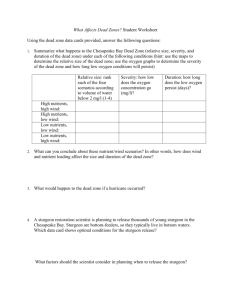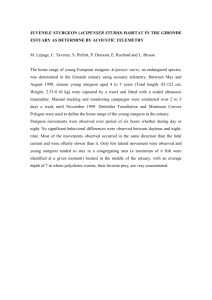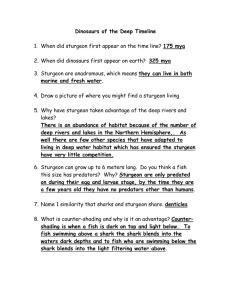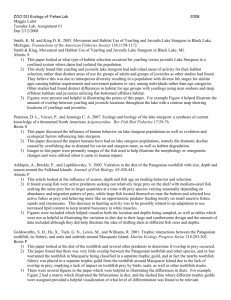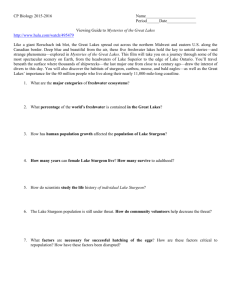Life history, habitat and distribution of the lake sturgeon Acipenser... Saskatchewan River, Alberta
advertisement
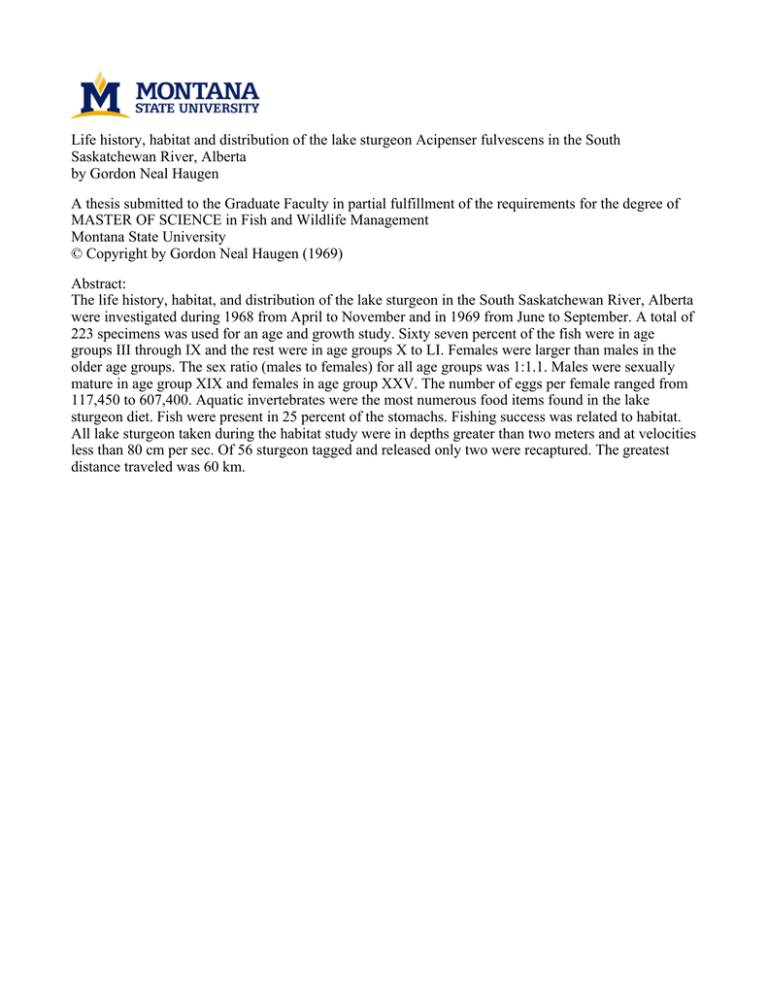
Life history, habitat and distribution of the lake sturgeon Acipenser fulvescens in the South Saskatchewan River, Alberta by Gordon Neal Haugen A thesis submitted to the Graduate Faculty in partial fulfillment of the requirements for the degree of MASTER OF SCIENCE in Fish and Wildlife Management Montana State University © Copyright by Gordon Neal Haugen (1969) Abstract: The life history, habitat, and distribution of the lake sturgeon in the South Saskatchewan River, Alberta were investigated during 1968 from April to November and in 1969 from June to September. A total of 223 specimens was used for an age and growth study. Sixty seven percent of the fish were in age groups III through IX and the rest were in age groups X to LI. Females were larger than males in the older age groups. The sex ratio (males to females) for all age groups was 1:1.1. Males were sexually mature in age group XIX and females in age group XXV. The number of eggs per female ranged from 117,450 to 607,400. Aquatic invertebrates were the most numerous food items found in the lake sturgeon diet. Fish were present in 25 percent of the stomachs. Fishing success was related to habitat. All lake sturgeon taken during the habitat study were in depths greater than two meters and at velocities less than 80 cm per sec. Of 56 sturgeon tagged and released only two were recaptured. The greatest distance traveled was 60 km. In presenting this thesis in partial fulfillment of the require­ ments for .an advanced degree at Montana State University, I agree that the Library shall make it freely available for inspection. I further agree that permission for extensive copying of this thesis for scholarly purposes .may be granted by my major professor, or, in his absence, by the Director of Libraries. It is understood that any copying or publica­ tion of this thesis for financial gain shall not be allowed without my written permission. Signature Date ? LIFE HISTORY, HABITAT AND DISTRIBUTION- OF THE- LAKE- STURGEON Acipensev fulvescens.m t h e s o u t h Sa s k a t c h e w a n r i v e r , a l b e r t a by GORDON NEAL HAUGEN A thesis submitted..to the Graduate'Faculty in partial fulfillment :of t h e .requirements .for the degree of MASTER OF SCIENCE in Fish and Wildlife Management Approved: Head, Major Department MONTANA:STATE UNIVERSITY Bozeman, Montana December, 1969 iii ACKNOWLEDGMENT The author wishes to thank the following: Dr= C= J= D= Brown directed the study and assisted in the preparation of the manuscript; Martin J. Paetz of the Alberta Fish and Wildlife Division suggested the study; Stanley Clements, John Pearson, Mal Clewes, Simon Moyer and William MacDonald aided with collections; my wife, Beverley gave help and encouragement. and Wildlife Division. The study was financed by the Alberta Fish iv TABLE GE CONTENTS Page VITA ........................ Ii. ACKNOWLEDGMENT . . . . . . . . . . . . ............ iii LIST OF T A B L E S ......................... LIST OF FIGURES' v ............... .■ . ...... . . ........... . ABSTRACT' .•............ vi vii INTRODUCTION .............................. I DESCRIPTION OF STUDY 2 METHODS, AREA . .. . . . . . . . ................... .................................. ................. .. . . . RESULTS 4. 7 Age and' Growth,- ....................... F e c u n d i t y .......... Sex R a t i o ............ Maturity . . . ... . -. . .... . . •. . ..... ...... .... Food ...... . ..................... Lake Sturgeon H a b i t a t ...... General Parameters . . . .- . ..... . ...... ... . ....... Habitat- i n ■Relation to Fishing S u c c e s s ................. Movement- ...... ................... ............... . .. . ...... LITERATURE CITED . . . . . ................... .................... 7 11. 13 1314 15. 17. 19 23 26. V LIST OF TABLES T able Page I . A g e , Number and Total Lengths (mm) of Lake Sturgeon from the South Saskatchewan River (April - November, 1968).......... .. II. III. IV. A g e , Lenth (mm), Weight (kg), Sex and Gonad Weight of Ripe and Spent Lake Sturgeon ........................... 14 Percentage Frequency of Occurrence (in parentheses) and percent ’ Composition by Number of Aggregate Lake Sturgeon Stomach Samples . .. ........................................ 16 Chemical Analyses of the South Saskatchewan River near Medicine Hat, January 1968 - December 1968 ....................... .. . 18 V. Physical Parameters in Areas I and 2, South Saskatchewan River ...................................... . . . . . . . . . VI. 8 22 Hours Fished, Hook Hours, and Numbers of Lake Sturgeon Taken in Areas I and 2. July 28, 1969 - August 8, 1969, South Saskatchewan .R i v e r .................................................... 23 vi LIST OF FIGURES' Figure I: Page Study area, showing locations of six sections . . . . . . . . . . . . 3 ...... 5 2. Cross sections of pectbgal rays from 3. Length of male and feitiale lake 'sturgeon from the South Saskatchewan River, A l b e r t a ................................... 4. 5. lake sturgeon 9■ Growth curve of lake sturgeon from the South Saskatchewan River, Alberta .................................... 1 Length-weight relationship of the lake sturgeon, from the South Saskatchewan- River,Alberta . . . . . . . . . . . . . . . . . . . 12 6. Section three representing Area I ........ 20 7. Section four representing Area 2 8. Bottom profiles along the thalwegs of the six sections showing approximate location of catch and number of lake sturgeon c a p t u r e d ............., ......................... ............. . . . . . . . . . .............................. 21 24 ABSTRACT The life history, habitat, and distribution of the lake sturgeon in the South Saskatchewan River, Alberta were investigated during '1968 .from April to November and in 1969 from June to September. A total of 223 specimens was used for an age and growth study. Sixty seven percent of the fish were in age groups III through IX and the rest were in age groups X to L I . Females were larger than itiales in the older age groups. The sex ratio (males to females) for all age groups was 1:1.1. Males were sexually mature in age group XIX and females in age group XXV. The number of eggs per female ranged from 117,450 to 607,400. Aquatic invertebrates were the most numerous food items -found in the lake sturgeon diet. Fish were present in 25 percent of the stomachs. Fishing success was related to habitat. All lake sturgeon taken during the habitat study were in depths greater than two meters and at velocities less than 80 cm per sec. Of 56 sturgeon tagged and released only two were recaptured. The greatest distance traveled was 60 km. INTRODUCTION The life history, habitat and distribution of the lake sturgeon, Acvpensev futvenseens (Rafinesque), were studied in the Alberta portion of the South Saskatchewan River during 1968 from April to November and in 1969 from June to September. The lake sturgeon is indigenous to the Hudson Bay, St. Lawrence (including the Great Lakes), and Mississippi River drainages. The species has been depleted throughout most of its range by over-exploitation and/or by man-made environmental changes (Harkness and Dymond, 1961). In Alberta the species is known to occur in the South Saskatchewan River from the confluences of the Bow and Oldman Rivers to the Saskatchewan border. Re­ ports of the species in the drainages above the confluences have not been confirmed. Prior to 1940 it was legal to take lake sturgeon, but after this date fishing was prohibited until 1968 when a limited fishery was permitted. The only available published work on lake sturgeon from the Saskatchewan River drainage is that of Royer (1968), who reported on age and growth of specimens taken in the Saskatchewan River Delta about 700 km downstream from the present study area. reported for: Other age and growth studies are Lake Nipigon, Ontario (Harkness, 1923); Lake St. Francis and the St. Lawrence River (Cuerrier and Roussow, 1951); Lake Winnebago Region, Wisconsin (Probst and Cooper, 1955); Nelson River, Manitoba (Sunde, 1959). harvest. The latter two studies included data on reproduction and Spawning periodicity was reported on by Roussow (1957), while the lake sturgeon, its history and problems of conservation were reviewed by Harkness and Dymond (1961). DESCRI P T I O N OF A R E A The present study was confined to the South Saskatchewan River in Alberta. The drainage exclusive of the Red Deer River lies in southern Alberta and northwestern Montana and has an area of approximately 67,340 square kilometers. Its tributaries drain the east slopes of the Rocky Mountains from Glacier National Park, Montana northerly to and including Banff National Park, Alberta. The Oldman and Bow Rivers which are its two major tributaries join to form the South Saskatchewan River 14 km north of Grassy Lake, Alberta (Figure I). — 3— <' ALTA. ^ o G rassy Lake M iles Kilometers Figure I. 10_________ 0 lb' '4 I) 10 10 20 20 Study area, showing locations of six sections. 30 ^ METHODS Attempts were made to catch lake sturgeon using set lines, gill nets, seines, and poison, but the set line was the only effective method„ Each consisted of a nylon line (25-100 meters in length) rigged with 3 to 50 hooks (size 6/0 and 8/0), baited with minnows. Set lines were fished in back waters during peak river discharge and in the main channel after high water subsided. Total and fork lengths of sturgeon were secured to the nearest milli­ meter and weights to the nearest 0.10 kilogram for those less than 5 kilograms in weight and to the nearest 0.25 kilogram for larger fish. Age determinations followed the method of Cuerrier (1951) with minor modifications. Pectoral fins were removed at their articulation with the body and dried. The first pectoral ray of each fin was sectioned (0.2 to 0.5 mm) at right angles to the long axis with a single carborundum blade. Sections were then emersed in 70 percent alcohol prior to annulus deter­ mination. (Figure 2). Annuli were considered to be the narrow dark concentric rings These were more easily distinguished at their greatest curva­ ture on the ventral-radial axis of the arrow-shaped sections. Growth rates were determined from empirical total lengths and not by back cal­ culation because of the extreme variation in the shape of pectoral rays. Sex determinations were made by examination of the gonads. were then weighed to the nearest gram. Gonads Sexual maturity stages followed the criteria described by Roussow (1957). -5- Figure 2. Cross sections of pectoral rays from lake sturgeon. A.- 785 mm 7-years-old. B.- 992 mm 13-years-old. C,- 1190 mm 19-years old. D.- 1480 mm 36-years-old. Photos by Don F n t t s . The food of the lake sturgeon was determined by examination of the stomach contents. enumerated. The organisms found were classified to order and The occurrence and numerical value of food items from aggre­ gate stomach samples were expressed as percentages. Morphometric data and study section locations were secured from aerial photos (1:2640) taken in 1962. Sections varied in length from 670 to 975 meters and transects perpendicular to the river channel were located at 62 meter intervals. Channel widths were measured by trangulation and areas with a planimeter. Depths were measured to the nearest 0.5 meters by a Furuno FG-200 depth recorder. Velocities were estimated by timing floats between transects and bottom types were classified according to Welch (1952). River discharge and water chemistry information were obtained from records of the Canada Department of Energy, Mines, and Resourcesd Water temperatures were recorded with a 30-day Rayan Thermograph. An attempt to determine lake sturgeon habitat was made by relating fishing success to the physical parameters of two areas (each comprised of three sections). A few observations were made on the movement of lake.sturgeon by tag and recovery. RESULTS Age and Growth Age was determined for 221 lake sturgeon taken in 1968 and for two collected near Medicine Hat in 1964. These latter were in age group II. Sixty-seven percent of the fish collected were in age groups III through IX. Twenty-nine age groups between X and LI years were represented but no more than seven fish were in any single age group (Table I ) . Length ranged from 208 mm in age group II to 1705 mm in age group LI. Size for given age groups varied between fish from the different locali­ ties, h o w e v e r n o t all sturgeon were taken on the same date and the number in each age group was small. Female sturgeon were slightly larger than males in older age groups (Figure 3). since samples were small. This may not be representative Royer (1968) observed a similar difference be­ tween males and females while Probst and Cooper (1957) reported no differ­ ence in size between male and female sturgeon. A growth curve was derived from combined data of all specimens taken in 1968 from my study sections (Figure 4). The growth rate was similar to that reported for sturgeon from the Saskatchewan River Delta and for Lake Winnebago. Mean growth increments varied from 263 mm (age groups II and III) to 54 mm (age groups VIII and IX), while the mean for age groups II through IX was 72 mm. were variable. In age groups older than IX sample sizes The mean increment was 24 mm for age group X through XXI and 13 mm for age group XXI through LI. -8- TABLE I „ Age group A g e , Number and Total Lengths (mm) of Lake Sturgeon from the South Saskatchewan River (April - November, 1,968) . No. fish Length mean Length range - II 2* 212 III 7 475 IV 21 586 553- V 17 64o • VI 33 VII No. fish Length mean Length range 3 1388 1130-1450 208- 217 XXVIII 2 1305 1130-1480 XXIX 2 1450 670 XXX I 1467 550- 682 XXXI - 7 3 9 . 575- 823 XXXII - 35 803 690- 907 XXXIII I 1580 VIII 15 853 700- 955 XXXIV I 1350 IX 22 907 770- 960 XXXV 3 1452 1 4 3 0 -1 4 8 0 X 5 976 8 0 0 -1 1 0 0 XXXVI - XI 5 1037 9 3 6 -1 0 7 0 XXXVII 2 1489 1 4 2 8 -1 5 0 0 XII 2 1003 1 0 0 0 -1 0 0 6 XXXVIII I 1600 XIII 4 1025 1 0 0 5 -1 0 3 5 XXXIX 0 XIV 7 1176 1 0 9 5 -1 1 2 5 XL 0 XVV 5 1137 9 8 0 -1 1 1 0 XLI 2 1476 XVI 3 1115 1 0 5 0 -1 1 8 0 XLII I 1350 XVII I 1122 XLIII - XVIII 2 1167 1 1 1 4 -1 1 6 7 ■ XLIV - XIX 6 '■ 1265 1 1 5 0 -1 3 9 0 XLV - XX 3 1291 1140-1375 XLVI - XXI I 1306 XLVII - XXII - XLVIII 2 1548 XXIII - LIX I 1500 XXIV - L I 1650 XXV 2 LI I 1705 XXVI I Lf\ CO LfN 1356 ^h 1 XXVII 5 I Age group 1135-1430 1350 * Taken in 1964 near Medicine Hat LU 1 4 6 0 -1 5 0 5 . 1 5 1 1 -1 5 8 5 -9- Fe m ales LENGTH IN MILLIMETERS M a les AGE IN YEARS Figure 3. Length of male and female lake sturgeon from the South Saskatchewan River, Alberta. -10- 2000 1800 1600 V) 06 1400 Ui 1200 1000 Z 800 6 Ui 600 400 200 * Tfc it sY™ afc Ifc AGE IN YEARS Figure 4. Growth curve of lake sturgeon from the South Saskatchewan River, Alberta. 56 -11- These results were similar to those of Royer (1968) who reported an average annual increment of 58 mm for age groups 0 through XX and 15 mm for age groups XX through XL for sturgeon from the Saskatchewan River Delta. The length-weight relationship of lake sturgeon was computed to be Log W = 9,067 + 3.28 log L, where W is weight in kilograms and L is total length in millimeters (Figure 5). this relationship is similar to that reported for lake sturgeon from other areas. Fecundity Only 3 of the 97 females had mature eggs in their ovaries. The number of eggs was calculated for each of these by weighing the ovaries and counting five sub-samples consisting of approximately five percent of the total ovary weight. The smallest female (1,350 mm) contained 117,450 eggs while the largest (1,705 mm) had 607,400 eggs. The average number of eggs per kilogram of fish weight was 1,188 while average per kilogram of ovary was 84,988. Cuerrier (1949) and Dubreuil and Cuerrier (1950) re­ ported on the fecundity of lake sturgeon for the Ottawa River and Lake St. Peters. Fish from Lake St. Peters averaged 36 pounds (16.34 kg) and contained 184,914 eggs and one weighing 79 pounds 370,910 eggs. (35.86 kg) had Harkness and Dymond (1961) suggested that 5,000 eggs per pound of fish is a reasonable number to expect in most lake sturgeon of 20 pounds or more in weight. - 12- WEIGHT IN KILOGRAMS LOG = - 9 . 0 6 7 + 3 . 2 8 6 - LOG L LENGTH IN MILLIMETERS Figure 5. Length-weight relationship of the lake sturgeon from the South Saskatchewan River, Alberta. The curve is the solution of the equation; the dots show the actual weights at various lengths. — 13— Sex Ratio The sex ratio of 224 lake sturgeon taken in 1968 was 1.1 males to I female. Males and females 'were about equally represented in year classes III through XJC, but females outnumbered the males 19 to 12 in the age groups greater than XX. Prbbst and Cooper (1955), Cuerrier (1949), and Sunde (1959) reported that younger lake sturgeon had approximately equal sex ratios while older fish were predominantly females. Maturity The gonads of 198 lake sturgeon were examined. The weights of paired testes ranges from 12 grams in year class III to 5 kilograms in year class . XXXIV. Paired ovary weights ranged from 13.5 grams in age group. IV to 7.5 kilograms in age group LI. females were ripe. Two males were spent while five males and three All ripe fish were taken after mid-July'and they pre­ sumably had spawned in the spring of 1969. The youngest male was XIX years and the youngest female XXV years (Table I D . The remaining fish in age groups greater than XlX were in varying stages of gonad development. .Roussow (1957) reports that maturity for both sexes is reached at VIII to XIII years and spawning usually occurs first at XII to XIX years for the males and XIV to XXIII for the females. Spawning periodicity varied be­ tween four and seven years for females. Cuerrier (1949) reported that maturity is reached at XIV years for males and XXIII years for females. — 14- TABLE II. Age, Years Age, Length (ihm) , Weight (kg) , Sex and Gonad Weight of Ripe and Spent Lake Sturgeon. Length (mm) Weight (kg) Sex Weight of Gonads (gm) 25 1350 15.50 F-R ■ 2,800 50 1650 32.00 F-R 4,062 28 1450 17.50 M-S 885 27 1387 19.75 M-S 763 48 1510 24.75 M-R 4,750 41 1505 25.00 M-R 5,000 19 1388 21.25 M-R 2,750 37 1428 23.00 M-R 3,250 35 1480 23.50 M-R 4,250 51 1705 45.50 F-R 7,500 M = Male F = Female S = Spent R . = Ripe Food Stomachs from 136 lake sturgeon taken from April through September 1968 were examined for food content. tained definable food organisms. stomachs. were: A tqtal of 116 (86.7 percent) con- Fragments of mollusks were present in all The percentage occurrence of aquatic invertebrates in stomachs Diptera larvae (Chironomidae and Tipulidae) 85=5 percent; Ephemer- optera nymphs 75.4 percent; Plecoptera nymphs 42.3 percent; Odonata nymphs 33.0 percent; and Trichoptera larvae 73.2 percent. Fish occurred in 25 -15- percent of the stomachs. stomachs. Harkness Some sand and fine' gravel were preent in all- (1923) reported that lake sturgeon from Lake Nipigon fed on ephemerid nymphs, chironmid larvae and mollusks and suggested that it feeds on the most abundant bottom organisms available and without preference. The stomach contents of large lake sturgeon show little selection in feeding, however in fish,- 600 nun or less in length, 62 percent of the-diet was dlptera, thus indicating a preference (Table III). Fish were present in 25 percent of the lake sturgeon greater than 600 mm in length. Probst and Cooper (1955) reported that fish were found only occasionally in lake sturgeon stomachs from the Lake Winnebago Region, Wisconsin and these were probably discarded bait, while Semakula- and Larkin (1969) reported that fish occurred in about half of the stomachs of white sturgeon kevpensev transmontanus taken in the Fraser River, British Columbia. Lake Sturgeon Habitat General observations were made on the physical, chemical and bio­ logical features of the South Saskatchewan River in an effort to define the,habitat of the lake sturgeon. This included about 300 km of river which is presumably occupied by this species-. Most of the data were se­ cured in the vicinity of Medicine Hat and may not be representative of the entire- river in Alberta. In addition, detailed physical information was secured for six sections (approximately six km) of river in relationto fishing success. TABLE III. Percentage Frequency, of Occurrence (in parentheses.), and Percent Composition by.-Number-.of~Aggregate. Lake ..Sturgeon-Stomach Samples. .......... .. 400-599.. ....... .... . .. Length .Classes.______________ 600-7-99... ..800=999-.... .,100.0-1199.. 1200t 1399. _________ 1400-1599 Total Stomachs Number. % empty .12 48 43 .14 10 9 136 0 4.4 6.5 1.5 .7 0 13.3 Food Items Insecta Diptera 62.0(100) Ephemeroptera, 8.8(25) Trichoptera Plecoptera. Odonata ■ * Not measured 27.1(77.7) 30.2(77.7) 25.0(83.3) 31.1(83.1) 28.6(66.6) 24.7(66.6) 33.7(75.4) 28.6(82,4) 27.1(77.7) 28.2(77.7) 21.4(73.2) 37.1(78.5) 28.9(83.3) 30.2(69.0) .5(16.6) I.0(8.3) Fish Mollusca 28.3(88.8) 35.9(85.3) 29.1(81.8) * 24.2(81.8) 1.5(23.8) 4.8(32.4) 10.3(100) 1.8(16.6) 1.9(29.4) 1.7(63.6)' 3.0(44.4) - I.0(4.7) 3.6(14.7) 3.4(54.5) 3.7(77.7) * * * 10.5(66.6) * 37.5(85.5) 9.4(88.8) 3.7(42.3) 1.6(44.4) 1.8(33.0) . 5.9(88.8) 2.9(25.0) * -17- General Parameters Peak discharge occurs in June and coincides with runoff from snow melt in the headwaters. mid-winter. Low flows come in late summer and again during An increase appears after low summer flows, resulting from reduced irrigational use. The mean monthly discharge during 1968 and 1969 ranged from 70 cms to 521 cms. 35 cms. Maximum discharge was 836 cms and minimum Maximum instantaneous discharge of 4,323 cms occurred on June I l , 1953 and a minimum of 10 cms on November 22, 1929. Annual monthly mean river temperatures recorded at Medicine Hat ranged from 2 C in December to 22 C in August. Daily temperatures were taken in section three from June through August of 1968 and 1969. They ranged from 13 C to 24.5 C. The highest temperature occurred on July 25, 1969 during a period when air temperatures exceeded 36 C . Chemical analyses were made on monthly samples taken in 1968 near Medicine Hat, Alberta (Table IV). The pH, total alkalinity, total hardi­ ness and conductance decreased during high water (June) and were at their maximum values during low flow (December and January). Turbidity on the other hand was highest in June during runoff. Algae blooms appeared in the upper reaches of the South Saskatchewan River during periods of low flow and probably resulted in part from do­ mestic and industrial effluents entering the Oldman River at Lethbridge and Taber. Rooted aquatic plants were common along the entire river. Other fish caught on set lines along with lake sturgeon, in the order of decreasing -18- TABLE IV. Chemical Analyses of the South Saskatchewan River near Medicine Hat, January 1968 - December 19621. Total Hardness (CaCO3) (ppm) Conductance @ 25° C (Microhoms) Date (1968) PH January 8.2 1.0 169 220 412 February 8.2 2.1 147 192 382 March 8.0 2.6 120 158 349 April 8.4 1.2 117 158 364 May 8.1 2.1 114 153 385 June 8.0 75.0 109 130 281 July 8.3 6.7 113 134 291 August 8.7 6,4 125 134 322 Sept­ ember 8.7 6.9 118 140 328 October 8.4 1.9 140 169 371 November 8.2 1.9 131 157 326 December 8.2 3.4 178 210 426 8.2 9.3 131 162 353 MEAN abundance , were: Turbidity (Jackson Units) Total Alkalinity (ppm) sauger(Stizestedien canadense)3 northern pike (Esex luoisii walleye (Stizosted-Cen vitreum), burbot (Leta lota), and rainbow trout (Salmo gairdneri)c Mountain whitefish (Presopinm williamsoni)s goldeye (Eiedon alesoides)3 flathead chub (Hybepsis gracilis)3 lake chub (Hybopsis plumbea)s emerald shiner (Netropis athevineides)3 spottail shiner (Netrepis hudsonius)3 longnose dace (Rhinichthys cataractae)3 quillback -19- carpsucker (Carpiodes CyprinusJ3 northern sucker (Catostomus CatostormsJ3 white sucker (Catostomus CommersoniJ3 mountain sucker (Pantosteus platy- rhnchusjs northern redhorse (Moxostoma macrotepidotumj3 trout-perch (Percopsis omiscomaycusJ3 and yellow perch (Perea flavesaens) were also present. Habitat in Relation to Fishing Success Two areas each composed of three sections were established for more intensive study. Area I (sections I, 3, and 5) was known to produce good fishing (Figure 6.), while Area 2 (sections 2, 4, and 6) was not used by fishermen and presumably supported few sturgeon (Figure 7). Parameters measured were area, width, gradient, velocity depth and bottom type (Table V). Area I was approximately 48 hectares, while Area 2 included 60 hec­ tares. Average depth and average thalweg depth were greater and velocities less in Area I than in Area 2. Sand-silt bottom made up 20 to 40 percent of the river bed in Area I and only 10 percent in Area 2. Other bottom materials were little different in the two areas. A total of 252 hours were spent fishing in each area using five set lines each equipped with 20 hooks mately 33 m long. (Table V I ) . Each set line was approxi­ These were distributed randomly through the areas. Eighty two percent of the 45 fish captured were taken from Area I and 18 percent from Area 2. This represents a catch of 0.76 per hectare (0.18 per hour) from Area I and 0.13 per hectare (0.03 per hour) in Area 2. The mean weight of the fish taken in Area I was 4.6 kg (range 2.5 to 16.5 kg) and 2.6 kg (range 2.6 to 10.5 kg) in area 2.' Kilograms of fish per hectare LEGEND Figure 6. Section three representing Area I. LEGEND •30.0---- 2.0 -- Bottom type: silt and sand - St g ra v e l--------- Gr rubble...............R boulders........ - B o Contour interval = 0.5 meters Figure 7. Section four representing Area 2. -22P h y sical P arameters in A reas I and 2 , S outh Sas k a t c h e w a n River. Area I 3 I H Average width (meters) 193 00 Area (hectares) M c— I 00 Parameters CO TABLE V. 194 5 2 Area 2 4 6 17.2 23.7 17.3 18.1 189 260 285 198 Average depth (meters) 2.0 2.5 4.0 1.0 1.0 1.3 Gradient (meters/kilometers) .54 .16 .21 .65 1 .20 .32 Average thalweg depth (meters) 2.0 3.7 3.7 1.8 1.4 1.3 .3 .4 1.0 1.6 1.4 Mean velocity (meters/second) .9 Bottom type (%) Sand-silt 25 20 40 . 10 10 10 Gravel 20 10 10 30 0 30 Rubble 55 40 40 50 70 50 0 30 10 10 20 10 Boulders were 3.5 in Area I. and 0»25 in Arqg -3.« An attempt was made to relate fishing success to physical parameters. Depth, velocity, and bottom were the only parameters which- could be re­ lated to fishing success. The first two were the most important. All lake, sturgeon were captured where thalweg depths exceeded two meters (Figure 8) and where velocities were less than 80 cm per sec. The bottom- material where 82 percent of the sturgeon were taken had a high percentage of sand-silt. The distribution of lake sturgeon is probably determined to a large extent by the interaction of these parameters. -23- TABLE VI. Hours Fished, Hook Hours, and Number of Lake Sturgeon Taken in Areas I and 2. July 28, 1 9 6 9 - August 8, 1969, South Saskatch­ ewan •River. Hours Fished Hook Hours 84 8,400 10 120 12,000 13 48 4,800 14 252 25,200 37 2 84 8,400 3 4 120 12,000 3 6 48 Sections I Area I 35 Area 2 No. Fish 4,800- 252 25,200 2 8 Movement Magnin and Beaulieu (1960) reported that 40 percent of recaptured lake sturgeon tagged in the St. Lawrence River moved less than 16 km and 70 percent less than. 54 km. Beaulieu and Corbeil (1964) related the move­ ment of lake sturgeon in Quebec to seasonal temperature changes. In- an attempt to determine the movement of lake sturgeon 21 were tagged and' released (August, 1968) in- the same, section where captured in the South' Saskatchewan River. Three were from, section one and 18 from- section- three. They ranged from 510- to 998 mm- in length. One of these was recaptured- in the same section where released (November, 1968) and' another in section one approximately 60 km upstream from the point of release (August/ 1969). — 24- Study Section 1500 1600 2i00 1700 2 ?> 5 1500 9 F6 meters 1600 Figure 8, 2400 3000 feet Bottom profiles along the thalwegs of the six sections showing approximate location of catch and number of lake sturgeon captured. -25- This latter fish- had grown from 775 to 780 mm in length during the interim. None of the 35 lake sturgeon tagged- in 1969- were recaptured. Lake sturgeon were more numerous in back-waters and along banks- in the spring (May and June). They moved into portions of the main channel where depths were greater than two meters in July and' remained throughout the fall and winter. These observations are similar to those reported for lake sturgeon in other areas. LITERATURE CITED Beaulieu-, Gerard and Etienne Corbeil= 1964. Stude Preliminaire De L'esturgeon De Lac,. ^Acifensev fulveseens) dans la ■region d'e I'Abitibi. Travaux sur Ies Pecheries du Quebec. No^ 4. Ministere ■ de I 1Industrie et du Commerce, Division- des- Peheries, Quebec. Cuerrier, J. P . 1949. Observations sur l'esturgeon de lac (Acifehsev futvesoens) dans la region du lac St. Pierre au cours de laperiode du frai. MS-. Cuerriery J. P . 1951. The use- of pectoral fin rays for determining’ age of sturgeon and other species- of .fish. Can. Fish Cult. No. 11: 10-18. ‘ Cuerrier, J. P . and G. Roussow. 1951. Age and growth- of lake sturgeon, from Lake St. Francis, St. Lawrence River. Report on material col^ lected- in 1947. Can. Fish Cult. No. 10: 17— 29. / DubreuiI, R. and J. P. Cuerrier. 1950. Rapport sur I'etude du cycle de maturation des, glandes genitales chez l'esturgeon de lac (A". fuivescens I^af;). .de la riviere Ottawa, 1949. Mimeo. Harkness,V '. J. K. 1923. The rate of growth and the food of the lake sturgeon (Aoifensev vubioundus) Univ.- Tor. Stud. Bio!. Ser. 24, Pub. Ont. Fish Res. Lab. 18. Harkness, W. J. K. and J. R. Dymond.- 1961. The. lake sturgeon. Ontario Dept, of Lands and Forests. Fish- &.Wildlife Branch. Dept, publication. 120 pp. Magnin, Etienne and- Gerard Beaulieu. 1960. Deplacements des Esturgeons(Aoifensev futvesoens- and Aeifensev oxyvhynohus) du Fleuve- SaintLaurent D'apr^s les. Donnees du Marquage. Department des- Pecheries., Quebec, No. 79, 237-252. Probst, R. and E . L. Cooper. 1955. Age, growth,and production of lake sturgeon (Aoifensev-futvesoens) in. the Lake Winnebago region Wisconsin. Trans. Am. Fish. Soc. 84: 207-227. Roussow, G. .1957. Some considerations concerning sturgeon spawning periodicity. J. Fish-. Res. Bd-. Can. 14: 553-572. Royer, L. M. 1968. Age and growth of lake sturgeon in the Saskatchewan River Delta. J. Fish.Res. Bd-. Can. 25(7): 1511-1516. -27- Semakula, S . N. and P. A. Larkin. 1968. Age, growth, food and yield of the white sturgeon (Aoi-'pensev transmontanus) of the- Fraser River, British Columbia. J. Fish Res. Bd. Can. 25(12): 2589-2602. Sunde, L. 1959. The sturgeon fishery in Manitoba with recommendations for management. Fisheries' Branch, Dept, of Mines and Resources-, Manitoba. M S . Welch, P. S . 1952. Limnology. New York. 538 pp. McGraw-Hill Book Company,-Inc., MONTANA STATE UNIVERSITY LIBRARIES 111 11111 Ii 111111 3 762 N378 H292 cop.2 001 421 2 2 Haugen, Gordon N. Life history, habitat and distribution of the lake sturgeon... A^D APPWCSS INTERLIBRMW LQMI I MAN 2 WEEKS Ii I T E a U B R A R X ^ A ^ ^ ^ /SXU WTERLIBRARV // ,a V J ijN u ss IN T 9 - - " ^
